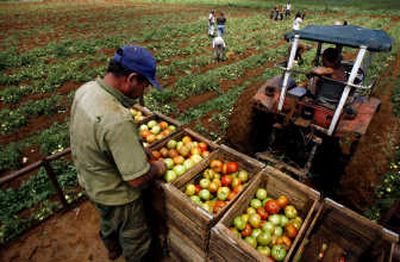In Cuba, urban farms an unexpected success

HAVANA – For Miladis Bouza, the global food crisis arrived two decades ago. Now, her efforts to climb out of it could serve as a model for people around the world struggling to feed their families.
Bouza was a research biologist, living a solidly middle-class existence, when the collapse of the Soviet Union – and the halt of its subsidized food shipments to Cuba – effectively cut her government salary to $3 a month. Suddenly, a trip to the grocery store was out of reach.
So she quit her job, and under a program championed by then-Defense Minister Raul Castro, asked the government for the right to farm an overgrown half-acre lot near her Havana home. Now, her husband tends rows of tomatoes, sweet potatoes and spinach, while Bouza, 48, sells the produce at a stall on a busy street.
Neighbors are happy with cheap vegetables fresh from the field. Bouza never lacks for fresh produce, and she pulls in between $100 to $250 a month – many times the average government salary of $19.
“All that money is mine,” she said. “The only thing I have to buy is protein” – meat.
Cuba’s urban farming program has been a stunning success. The farms, many of them on tiny plots like Bouza’s, now supply much of Cuba’s vegetables. They also provide 350,000 jobs nationwide with relatively high pay and have transformed eating habits in a nation accustomed to a less-than-ideal diet of rice, beans and canned goods from Eastern Europe.
From 1989-93, Cubans went from eating an average of 3,004 calories a day to only 2,323, according to the U.N. Food and Agriculture Organization, as shelves emptied of the Soviet goods that made up two-thirds of Cuba’s food. Today, they eat 3,547 calories a day – more than what the U.S. government recommends for American citizens.
“It’s a really interesting model looking at what’s possible in a nation that’s 80 percent urban,” said Catherine Murphy, a California sociologist who spent a decade studying farms in Havana. “It shows that cities can produce huge amounts of their own food, and you get all kinds of social and ecological benefits.”
Of course, urban farms might not be such a success in a healthy, competitive economy.
As it is, productivity is low at Cuba’s large, state-run farms where workers lack incentives. Government-supplied rations – mostly imported from the U.S. – provide such staples as rice, beans and cooking oil, but not fresh produce. Importers bring in only what central planners want, so the market doesn’t correct for gaps. And because most land is owned by the state, developers are not competing for the vacant lots that can become plots for vegetables.
Still, experts say the basic idea behind urban farming has a lot of promise.
“It’s land that otherwise would be sitting idle. It requires little or no transportation to get (produce) to market,” said Bill Messina, an agricultural economist at the University of Florida in Gainesville. “It’s good any way you look at it.”
And with fuel prices and food shortages causing unrest and hunger across the world, many say the Cuban model should spread.
“There are certain issues where we think Cuba has a lot to teach the world. Urban agriculture is one of them,” said Beat Schmid, coordinator of Cuba programs for the charity Oxfam International.
Other countries have experimented with urban farming. Cuba’s initial steps were modeled after a green belt surrounding Shanghai. But nowhere has urban farming been used so widely to transform the way a country feeds itself.
“As the global food crisis receives attention, this is something that we need to be looking at,” Murphy said. “Havana is an unlikely, really successful model where no one would expect one to come from.”